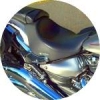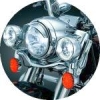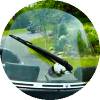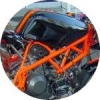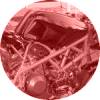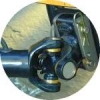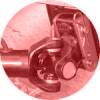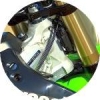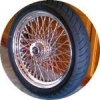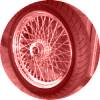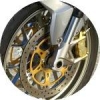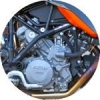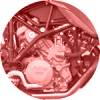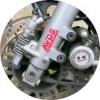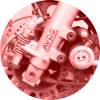|
Queensland Department of Transport and Main Roads introduced the safety certificate in November 1999 to replace the old roadworthy certificate or RWC, and it became
mandatory to obtain and display a current safety certificate on any registered motorcycle from the moment it's offered for sale.
The only times it's not required to display current safety certificate on a motorcycle for sale is when the motorcycle's either unregistered or is traded to or
between licensed motor dealers.
Queensland Department of Transport and Main Roads safety certificates can only be issued by Approved Inspection Stations (AIS), being service stations, garages or
workshops approved by Queensland Department of Transport and Main Roads to conduct inspections.
For private motorcycle sellers, Queensland Department of Transport and Main Roads safety certificates must be issued in the two months or 2000 kilometres prior to
sale, whichever comes first.
You are required to display a safety certificate in a conspicuous place and for motorcycles it's either on the forks or front guard.
Failure to display a Queensland Department of Transport and Main Roads safety certificate on the motorcycle from the time it's first offered for sale can carry an
on-the-spot fine penalty of $550.
Information on this website relating to motorcycle inspection is drawn from the Queensland Department of Transport and Main Roads Code of Practice for Approved
Inspection Stations (AIS) and Approved Persons; guidelines followed during safety certificate inspections and vehicle modification certification.
Following the code of practice guidelines below and rectifying faults you uncover should assure your motorcycle will pass on first inspection, avoiding any inconvenient
and possible costly re-inspection.
TOW COUPLING INSPECTION GUIDELINES
Vehicle inspection is subjective and the guidelines open to varying interpretation from inspector to inspector. Below is a list of reasons for possible rejection
pertaining to the Tow Couplings for the issuing of a Queensland Department of Transport and Main Roads safety certificate (formerly roadworthy certificate or RWC).
SECTION 5 - TOW COUPLINGS
Objective: To ensure that all tow couplings and associated components are in a serviceable condition and that they provide the necessary load carrying
capacity.
In this section:-
Coupling device includes tow bars, tow hooks, automatic pin type couplings, fifth wheels/turntables, skid plates, king pins, mounting bolts and any
attachments for any of the items listed.
Coupling connector includes electrical wiring and flexible pipes.
Safety chain includes a cable that performs the same function.
5.1 TOW COUPLINGS, WIRING HARNESS AND SAFETY CHAIN ATTACHMENT POINTS
Possible reasons for inspection rejection:
- Where ADR 62 applies, the tow coupling does not display the name or trademark of the manufacturer, the make and model of the vehicle
for which the tow coupling is designed and the tow coupling maximum rated capacity.
- Any locking mechanism associated with the coupling assembly or its attachment to the vehicle is missing, not fitted, inoperative,
damaged or worn to an extent that the coupling is not secured and held in place within manufacturer's tolerances.
- Any part of the tow bar is cracked, excessively worn or repaired by heating or welding.
- The tow bar is not mounted directly to the frame or through rigid connections to the frame.
- Tow coupling tongue assemblies are not securely mounted to the tow bar/frame assembly.
- A 50mm tow ball assembly (if fitted) is not legibly and indelibly marked with the mark "50" in characters not less than 5mm high.
- Where any part of the coupling or tow bar is removable, the bolts, studs, nuts etc. fastening those parts do not have a locking device
such as an R-clip, split pin, spring washer or nylon lock nut.
- Safety chain or cable attachment points are damaged or worn which may allow accidental disconnection of the chain or cable.
- Coupling devices are not operational, missing, not secure, cracked, corroded, excessively worn, deformed or damaged in a way likely to
cause failure.
- Pin couplings or pintle hooks are worn beyond manufacturer's limits or, if the manufacturer's limits are not known, any dimension on a
wear surface of the horn of a pintle hook or pin coupling is worn by more than 5% of the original diameter.
- All coupling devices and coupling connectors associated with a device for coupling a trailer to a motor vehicle are not operational,
not secure, or are cracked, corroded, excessively worn, leaking, deformed or damaged in a way likely to cause failure.
- An adaptor is used to fit a kingpin to a fifth wheel coupling. (See Note 2)
- Tow couplings are repaired by heating or welding.
- Tow couplings are not securely mounted to the trailer drawbar.
- The coupling is not of a positive locking type and not fitted with an efficient and secure latching/fastening device.
- The drawbar of a trailer is not securely fixed to the trailer frame/chassis.
- Any sliding drawbar stops or latching mechanism is faulty or inoperative.
- All drawbar components and coupling devices are not free of cracks, corrosion, distortion, misalignment or other damage.
- Drawbar eye is elongated by wear, cracked or worn by more than 5% of the original diameter or manufacturer's specifications.
- Drawbar eye bush is worn through or beyond manufacturer's specifications, is insecure or is attached by welding (unless the
manufacturer specifies welding).
- Where any part of the coupling, drawbar or tow bar is removable, the bolts, studs, nuts etc. fastening those parts do not have a
locking device such as a U-clip, split pin, spring washer or nylon lock nut.
- Safety chain/s (as required) are not securely attached to the trailer drawbar. (See Notes 3)
- On rigid drawbar pig trailers in excess of 2.5 tonnes GTM or other trailers in excess of 3.5 tonnes ATM, there are less than 2 chains
of adequate diameter. (See Notes 3 and 4)
- Breakaway brakes on any rigid drawbar pig trailer with an ATM of 2.5 tonnes or more are not capable of activating before the safety
chains have broken or the drawbar touches the ground.
- Safety chains (if required) are stretched, nicked, frayed, excessively corroded or cracked.
- Any trailer without breakaway brakes is not fitted with at least one safety chain of the nominated size and the specified rated
capacity. (See Note 4)
- Trailers with an Aggregate Trailer Mass (ATM): (See Note 1)
- of 2.5 tonnes or less, do not have at least one safety chain capable of being attached to the towing vehicle; (See Notes 3 and
4)
- greater than 2.5 tonnes, do not have two safety chains capable of being attached to the towing vehicle. (See Notes 3 and 4)
- The length of the safety chain/s does not prevent the trailer's drawbar hitting the ground if the trailer is detached from the towing
vehicle and there is at least one safety chain which is not positioned such that it prevents the drawbar from touching the ground when the drawbar is detached.
5.2 TOWING CAPACITY
Possible reasons for inspection rejection:
- In the case of trailers manufactured after 1 July 1988, the tow coupling manufacturer's name or trade mark and maximum operating capacity is not displayed on the
coupling in a conspicuous position.
Notes about Section 5 (Tow Couplings):
[1] Aggregate Trailer Mass (ATM) is the total mass of the laden trailer when carrying the maximum load recommended by the manufacturer. This includes any mass
imposed onto the drawing vehicle when the combination vehicle is resting on a horizontal supporting plane. Therefore, the ATM is the mass of the fully laden trailer
when it is not connected to the towing vehicle.
[2] An example of this is where an adaptor is used to convert a 50mm kingpin into a 75mm kingpin.
[3] The Transport Operations (Road Use Management - Vehicle Standards and Safety) Regulation 2010 requires that a trailer which is in a combination and is not fitted
with breakaway brake, must be connected to the towing vehicle by at least one (1) chain, cable or other flexible device (the "connection") as well as the coupling.
The fitting of safety chains on other types of trailers fitted with an emergency brake system (breakaway) is optional.
In addition to that stated above, departmental policy requires safety chains on all fixed or rigid drawbar pig trailers with a GTM greater than 2.5 tonnes and fitted
with an automatic pin type coupling, irrespective of whether the trailer is fitted with a breakaway brake system or not.
[4] Information about minimum chain and shackle sizes is available in Information Sheet No. 12 in Vehicle Standards Instruction G21 - Information Sheets for Approved
Examiners or the Safe Towing Guide available at www.tmr.qld.gov.au.
To comply with this requirement, the brake connection between the vehicle and trailer must be short enough to cause disconnection before full extension of the safety
chains.
If you require further information about safety certificate inspections or inspection guidelines phone
Brian Harper
at
MOTORCYCLE ROADWORTHYS
on
1800 BIKE RWC
1800 245 359
or
0402 544 115
WE ACCEPT

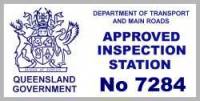
|

















